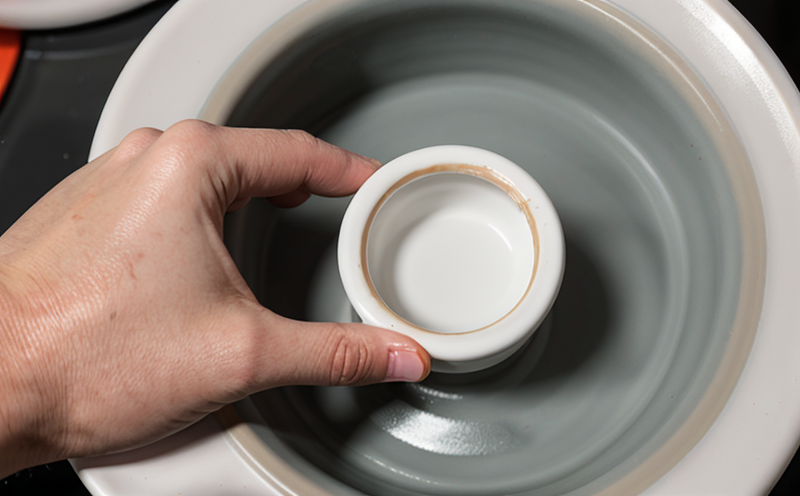ASTM C1469 Shear Strength of Nanostructured Ceramic Components
The ASTM C1469 standard provides a comprehensive methodology for determining the shear strength of nanostructured ceramic components. This testing procedure is particularly relevant in sectors where advanced ceramics are used, such as aerospace, automotive, and electronics manufacturing. The nanoscale structure of these materials confers unique properties that make them essential for high-performance applications.
The test involves subjecting a sample to a shear force until it fails. This requires precise control over loading conditions and environmental factors to ensure accurate results. Nanostructured ceramics exhibit distinct mechanical behaviors due to their microstructure, which can significantly affect the outcome of this test. Understanding these nuances is crucial for quality assurance and compliance.
The ASTM C1469 standard specifies detailed procedures for sample preparation, including grinding and polishing techniques tailored to the nanoscale features of the material. The choice of specimen shape (e.g., cylindrical or disc) influences the results, as does the orientation of the loading axis relative to the grain structure.
The shear strength is determined by measuring the force required to cause failure at a specific location within the sample. This location must be accurately identified and marked before testing begins. The standard also outlines guidelines for reporting test data, ensuring consistency across different laboratories and batches of materials.
Testing nanostructured ceramics presents unique challenges due to their small grain size and complex microstructure. These characteristics can lead to variations in mechanical properties, necessitating careful sample preparation and robust testing protocols. Accurate measurement of shear strength is vital for assessing the performance and reliability of these materials in real-world applications.
The ASTM C1469 standard ensures that tests are conducted under controlled conditions, minimizing variability introduced by external factors. This consistency allows for reliable comparisons between different batches of material or between laboratory results. The test can also be used to evaluate the effects of processing parameters on shear strength, aiding in process optimization and quality control.
By adhering to ASTM C1469, laboratories ensure that their testing procedures meet international standards, enhancing credibility and trust with clients and stakeholders. This is particularly important in sectors where regulatory compliance is critical, such as aerospace and defense.
The test's precision and repeatability are essential for quality assurance and reliability assessment of nanostructured ceramics. Understanding the shear strength helps predict how these materials will perform under actual loading conditions, ensuring they meet design specifications and safety requirements.
Why Choose This Test
The ASTM C1469 test is essential for several reasons:
- Regulatory Compliance: Adhering to international standards ensures that products comply with regulatory requirements, enhancing market access.
- Quality Assurance: Consistent and accurate testing helps maintain product quality across batches and manufacturing runs.
- Process Optimization: By evaluating the effects of processing parameters on shear strength, laboratories can refine production processes for better outcomes.
- R&D Support: Understanding material properties aids in research and development efforts, leading to innovation and technological advancement.
The test's precision and repeatability make it a valuable tool for quality managers, compliance officers, R&D engineers, and procurement professionals. It provides critical data needed to ensure that nanostructured ceramics meet performance expectations and safety standards.
Quality and Reliability Assurance
Quality assurance in the context of ASTM C1469 involves ensuring that all testing procedures follow the specified guidelines meticulously. This includes precise sample preparation, accurate force measurement, and consistent reporting methods. By adhering to these standards, laboratories can produce reliable data that supports decision-making processes.
The reliability of nanostructured ceramics is paramount for their successful integration into various industries. ASTM C1469 helps ensure that the materials used meet stringent performance criteria, thereby enhancing overall product quality. This standard also plays a crucial role in maintaining safety standards by ensuring that materials perform as expected under loading conditions.
Quality assurance through this testing method involves rigorous protocols at every stage of the process—from sample preparation to data analysis. Each step must be meticulously documented and reviewed to ensure consistency and accuracy. By doing so, laboratories can provide confidence in their results, which is essential for stakeholders across multiple sectors.
The use of ASTM C1469 supports compliance with international standards and enhances credibility within the industry. This standard ensures that all tests are conducted under controlled conditions, minimizing variability introduced by external factors. The result is a high level of trustworthiness in laboratory results, which is vital for maintaining quality assurance practices.
Reliability is ensured through consistent testing procedures that adhere to ASTM C1469 standards. This consistency allows for reliable comparisons between different batches of material or between laboratory results. By adhering to these guidelines, laboratories can provide accurate and reproducible data, supporting informed decision-making processes across various industries.
Competitive Advantage and Market Impact
- Innovation Leadership: By mastering ASTM C1469 testing, companies stay ahead of the curve in developing cutting-edge nanostructured ceramics.
- Enhanced Reputation: Adherence to international standards boosts a company's reputation among clients and partners.
- Better Decision-Making: Accurate test results enable informed decisions about material selection, process optimization, and product development.
- Increased Market Share: Compliance with industry standards can lead to increased market share by meeting customer expectations and regulatory requirements.
The ability to perform ASTM C1469 testing accurately and consistently provides a significant competitive advantage. It allows companies to demonstrate their commitment to quality, reliability, and innovation, which are highly valued in the market. By ensuring that nanostructured ceramics meet stringent performance criteria, businesses can enhance product performance, safety, and overall customer satisfaction.
The use of ASTM C1469 testing also supports compliance with industry standards and enhances a company's reputation among clients and partners. This standard ensures that all tests are conducted under controlled conditions, minimizing variability introduced by external factors. The result is high-trustworthiness in laboratory results, which is essential for maintaining quality assurance practices.





